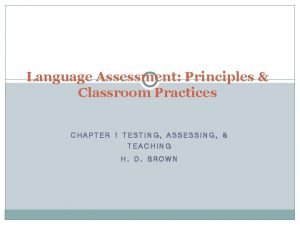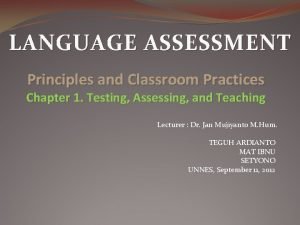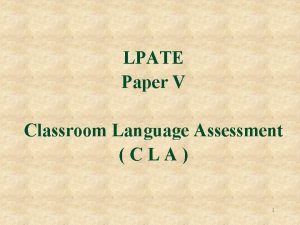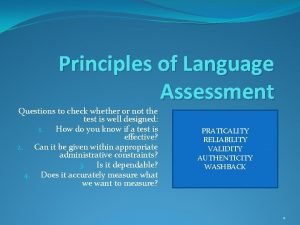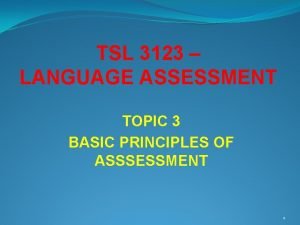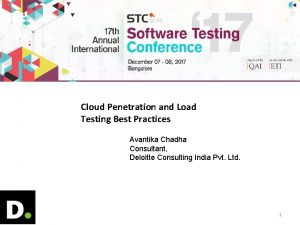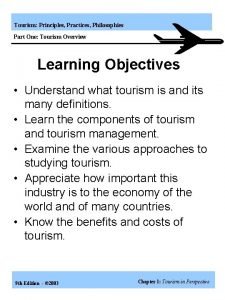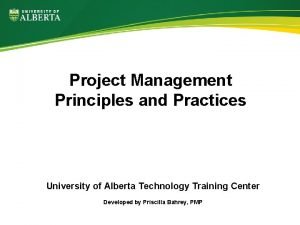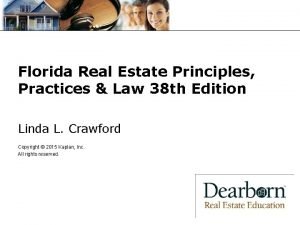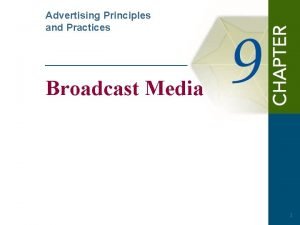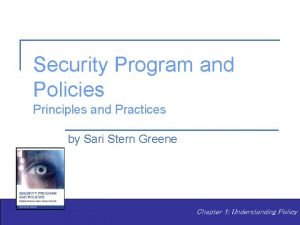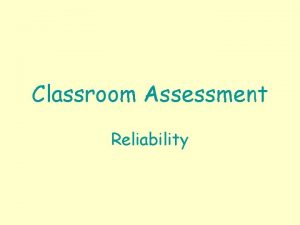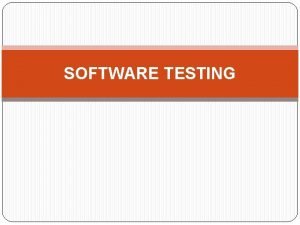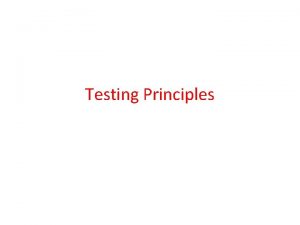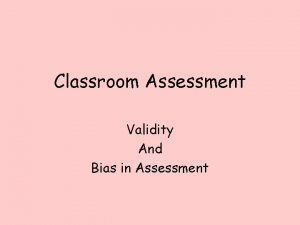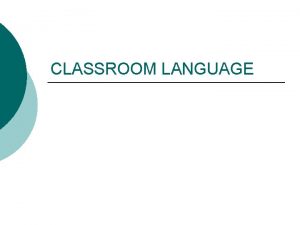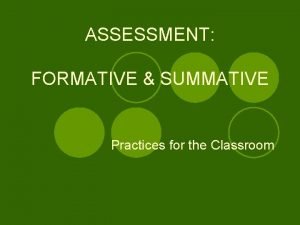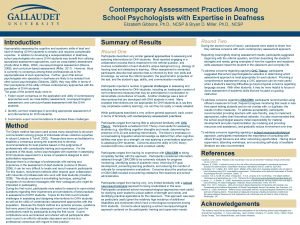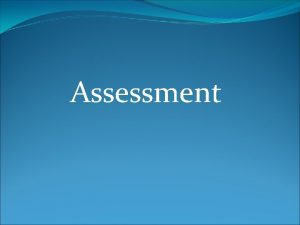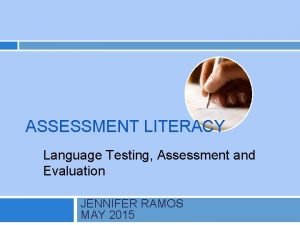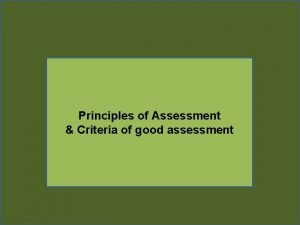Language Assessment Principles Classroom Practices CHAPTER 1 TESTING















- Slides: 15

Language Assessment: Principles & Classroom Practices CHAPTER 1 TESTING, ASSESSING, & TEACHING H. D. BROWN

What is a test? Test, Evaluation, Assessment? -Test: method of measuring a person’s ability, knowledge, or performance in a given domain -Indirect nature of testing: judge competence based on limited information on one’s performance & problem of generalization & interpretation

Assessment and Teaching Assessment: an ongoing process that encompasses a much wider domain and it is done to make important curricular & instructional decisions or judge learners’ abilities in language domains - Assessment should be based on solid theories & research! - Test is a subset of assessment and its score is different from the interpretation of the result.

Assessment and Teaching Evaluation (평가): a systematic way of performance in a given context and a bigger concept dealing with tests, assessment, and judgments based on national and institutional policies Relationship of tests, assessment, and teaching (Figure 1. 1) : teaching as a ground for ample opportunities to “play” with language for meaningful learning

Informal & Formal Assessment Informal assessment in classroom Formal assessment: planned, systematic, time-constrained, based on a limited sample of behaviors; Something is at stake! (e. g. , stake-high exams) All tests are formal assessment but not all assessment are formal.

Formative & Summative Assessment Formative Assessment (형성평가): look into “forming” one’s competences to help learners to develop more Summative Assessment(종합평가): measure or summarize one’s performance at the end of a course or instruction When all tests are considered “summative”, attrition of learning occurs!

Norm-referenced & Criterion-references tests Norm-referenced tests: compare results with others using mean, median, standard deviation, percentile rank, etc. -Most standardized tests are normreferenced tests. Criterion-referenced tests: All those who reach certain criteria can pass!; more for feedback on specific course or lesson objectives

Approaches to Language Testing: A Brief Histoy 1950 s: test discrete elements of language 1970 s-1980 s: integrative view of testing Discrete-point vs. Integrative Testing: Issue of (de)contextualization & authenticity Cloze test & dictation as integrative testing Unitary trait hypothesis (Oller, 1983): “indivisible” nature of language

Communicative Language Testing Canale & Swain (1980): grammatical, discourse, sociocultural, strategic competences Bachman (1990): Organizational & Pragmatic competences Bachman & Palmer (1996): Strategic competence

Performance-based Assessment Types of PBA: oral interview, written essays, open-ended Q & A, integrated skills performance, group performance, interactive tasks Importance of language use and authenticity but one may question the reliability of scoring!

Current Issues in Classroom Testing New Views on Intelligence -Alfred Binet vs. H. Gardner’s multiple intelligence(MI): linguistic, logicalmathematical, spatial, musical, bodilykinesthetic, interpersonal, intrapersonal intelligences -Goleman’s EQ(emotional quotient) -tyranny of objectivity in high-stake testing

Current Issues in Classroom Testing Traditional vs Alternative Assessment -one-shot, standardized vs. continuous & long -term -timed, multiple choice vs. untimed, freeresponse -decontextualized vs. contextualized -scores only vs. individualized feedback -norm-referenced vs. criterion-referenced

Current Issues in Classroom Testing Traditional vs Alternative Assessment -summative vs. formative -product-oriented vs. process-oriented -non-interactive vs. interactive performance -extrinsic vs. intrinsic motivation Beware of a bias toward alternative assessment!

Current Issues in Classroom Testing Computer-based Testing(CBT) -Computer-adaptive test(CAT) -Internet-based test(IBT) -based on Item Response Theory(IRT): 문항반응이론 -See advantages & disadvantages (p. 15)

Basic Principles Suggested 1. Periodic assessment 2. Appropriate assessment 3. Pinpoint strengths and weaknesses 4. Periodic closure to modules within a curriculum 5. Promote student autonomy by encouraging self-evaluation of their progress 6. Help learners set their own goals 7. Aid in evaluating teaching effectiveness
 Language assessment: principles and classroom practices
Language assessment: principles and classroom practices Summative evaluation
Summative evaluation Lpat past paper
Lpat past paper Principles of language assessment
Principles of language assessment Sourima mal
Sourima mal Principle of language assessment
Principle of language assessment Cloud performance testing best practices
Cloud performance testing best practices Current issues in classroom testing
Current issues in classroom testing Representing motion physics answers chapter 2
Representing motion physics answers chapter 2 Tourism: principles, practices, philosophies
Tourism: principles, practices, philosophies Sdlc principles and practices
Sdlc principles and practices University of alberta project management
University of alberta project management Florida real estate principles practices & law
Florida real estate principles practices & law Broadcasting principles and practices
Broadcasting principles and practices Involuntary inactive real estate license florida
Involuntary inactive real estate license florida Security program and policies principles and practices
Security program and policies principles and practices
